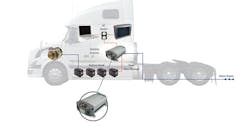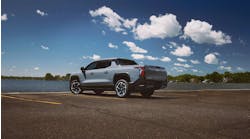Downtime is bottom-line killer in trucking operations, which can cost anywhere from $480 to $760 a day per vehicle, according to a survey maintenance software firm Decisiv conducted last year.
Dead batteries are one big source of truck downtime, which is but one of several reasons Don Wilson, technical applications engineer with Xantrex, thinks factory-installed inverter/chargers can be a big cost-saver for commercial fleets. Fleet Owner got a chance to ask Wilson a few detailed questions about this technology and why he thinks it can be a boon in over-the-road operations.
Q: Why is having an inverter/charger onboard a Class 8 rig important to today’s commercial vehicle operator? What are the most critical reasons that one should be aboard?
When parked at an electrified truck stop, an inverter/charger will help keep the batteries topped off in the morning. Also, when putting a truck out of commission for a while, a charger can make sure the battery can start the truck when put back in commission. The inverter part of the inverter/charger will make AC power available in all receptacles inside the sleeper cab. It is extremely important to have a reliable source of onboard AC power for sensitive equipment such as CPAP machines and other essential electronics.
Q: How big an issue is weight with inverter/chargers? Many fleets are going over every pound with a fine-tooth comb in order to boost payload/fuel economy.
A: Inverter/chargers come in various form factors. Our products offered through major truck manufacturers come in a compact footprint weighing roughly 12 to 13 pounds. In the grand scheme of things, meaning impact on overall payload, this weight is almost negligible.
Q: How much maintenance do such units typically require and how can they be integrated into standard maintenance programs? For example, every time the oil is changed, the inverter should be serviced?
A: Inverter/chargers need no maintenance and can actually help decrease the amount of maintenance on the battery. Quality inverter/chargers are equipped with various protection features such as overload, over temperature, under/over voltage, low battery voltage which helps increase the life of an inverter.
Q: How long a lifespan should be expected with an inverter/charger? How does duty cycle impact lifespan?
A: We offer a two-year warranty, but eight to 10 years is not at all unusual. All of our Xantrex products meet UL458 and TMC RP163 requirements for safety, quality and reliability. In a nutshell, as I said before, quality inverters have so many built-in protection features that they are able to withstand heavy-duty cycles for a longer period of time. The inverter/charger will resist spikes and over loads and stop before its internal components and circuits are exposed and ultimately damaged.
Q: Why should fleets consider adding inverter/chargers to their Class 8 trucks?
A: Many reasons: providing onboard AC power; the ability to use shore power to charge batteries; the ability to “pass through” incoming shore power to operate hotel loads when the trucks are parked at truck stops. In fact, an inverter/charger enables a truck driver to enjoy the comforts of home while on the road.
A sleeper with any of the following is an ideal candidate for an inverter/charger:
- TV
- CPAP
- Refrigerator
- Microwave
Q: Finally, how about a ‘do’ and ‘do not’ list for how inverter/chargers are installed and used?
A: I do not recommend a truck driver doing self-installation. You’re dealing with electricity. So if you’re not comfortable handling wiring at your house, you better not try it in your rig.
If you’re working on a 12-volt lighter plug or a 300 watt inverter for the laptop, installation should prove to be no problem. But for larger inverters that require hard-wiring, fusing, voltage-drop calculations, and knowledge of applicable safety standards, I cannot stress enough how important it is to get it right the first time.
There is a bevy of things to consider when installing an inverter, starting with “where it should go” and making sure there is adequate ventilation to allow heat to dissipate. And you have to look at wire sizing, the distance between the inverter and plug-ins, which can be put in the sleeper, plus the distance between the battery and inverter.
We really recommend either an OEM install – on the factory assembly line or done via pre-delivery inspection – when you purchase a new truck, or have the installation done by an authorized dealer. The OEMs have installation down to a science and it’s done on the line to rigid specs.
Truck and aftermarket dealers also have the experience, so it’s worth spending a few extra bucks to have the installation done right, the first time.




